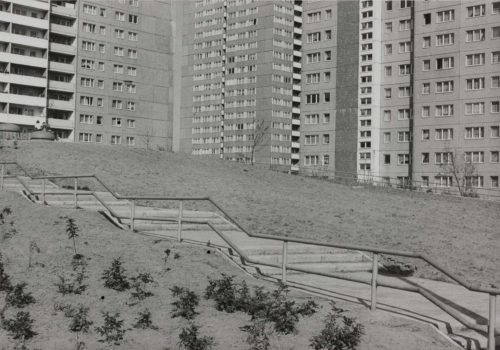The European Month of Photography began in Berlin in mid-October. One of the main exhibitions of the program is the one organized by the Berlinische Galerie on art photography from the German Democratic Republic. It collects 260 photographs taken by 34 different artists.
This is the first major exhibition of East German photography since the fall of the Berlin Wall more than twenty years ago. What does the photography convey? What was daily life like for East Germans at the time? What were artists concerned with? Combining different themes and aesthetic approaches , the exhibition is divided into three chapters, offering a broad view of the photography during this forty-year period. The series on view also relate to stories from daily life and the characteristics of art, society and politics.
Although they aren’t the first images to appear on the walls of the exhibition, they serve as a prologue and as context, and we begin with them: pictures of the city of Dresden demolished by Allied bombings, taken in 1946 by Richard Peter (1895 – 1977). We are supposed to have already seen these images and remember them, but seeing them again, and the extent of the damage, has a strong symbolic effect. What happened after the fall of the Third Reich, from the founding of the German Democratic Republic until the collapse of the Communist bloc? This exhibition provides some answers in the form of photographs, some better known than others, but all taken by those who lived it.
The documentary section of the exhibition is of particular interest: a dozen photographers and highly different visions of Berlin and other East German cities, with an emphasis always on people and places. Evelyn Richter’s photographs of women at work show a social turning point in postwar Germany. Outside, Arno Fischer photographs street activity in Berlin in the late 1950s, and Ulrich Wüst highlights the lingering emptiness of certain East German cities in the early 1980s. Roger Melis is known for his portraits of German artists, like the playwright Heiner Müller, photographed in the intimacy of their homes. Christine Borchat also worked inside, taking a series of family portraits: parents and children around the dining room or kitchen table. All social classes are represented in the exhibition: butchers, dentists, psychologists, policemen and sculptors, for example, but we always feel a certain austerity. Smiles and laughter seem almost forbidden.
Photographers of « The Shuttered Society » : Ursula Arnold, Tina Bara, Sibylle Bergemann, Christian Borchert, Micha Brendel, Kurt Buchwald, Lutz Dammbeck, Klaus Elle, Arno Fischer, Thomas Florschuetz, Ernst Goldberg, Klaus Hähner-Springmühl, Matthias Hoch, Edmund Kesting, Fritz Kühn, Matthias Leupold, Ulrich Lindner, Karl Heinz Mai, Sven Marquardt, Roger Melis, Florian Merkel, Peter Oehlmann, Helga Paris, Manfred Paul, Richard Peter sen., Evelyn Richter, Jens Rötzsch, Rudolf Schäfer, Michael Scheffer, Erasmus Schröter, Gundula Schulze-Eldowy, Maria Sewcz, Ulrich Wüst
Read the full text of this article by Eva Gravayat in the French version of Le Journal.
The Shuttered Society – Art Photography in the GDR 1949-1989
From October 5th 2012 to January 28th, 2013
Curators :
Ulrich Domröse, T. O. Immisch, Gabriele Muschter, Uwe Warnke
Berlinische Galerie
Alte Jakobstraße 124
128
10969 Berlin – Germany
















